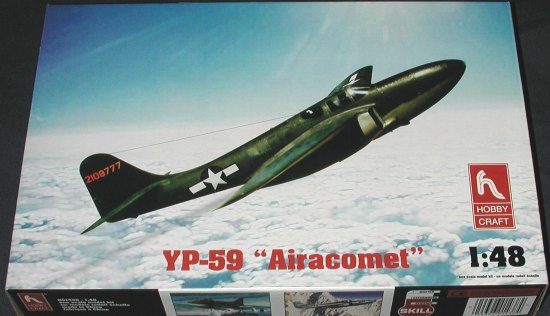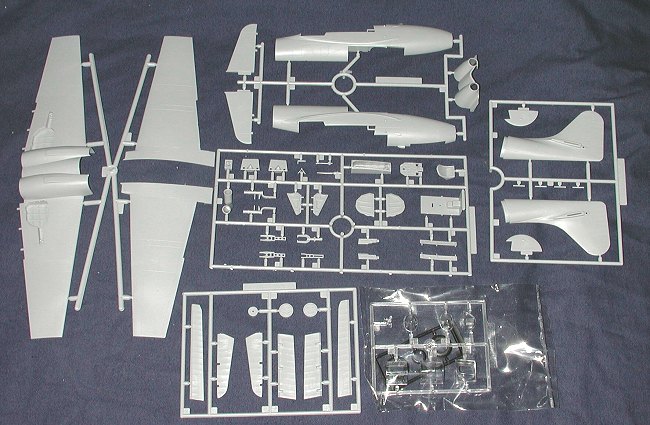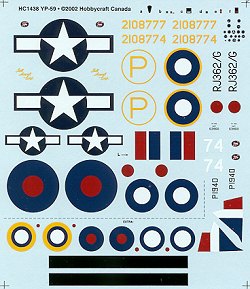
|
KIT: |
Hobbycraft 1/48 YP-59 Airacomet |
|
KIT # |
HC 1438 |
|
PRICE: |
$26.00 |
|
DECALS: |
Four aircraft |
|
REVIEWER: |
|
|
NOTES: |
New mold |

|
HISTORY |
In April of 1941, Major-General H. H.
Arnold was on a visit to Britain. As part of his visit he was shown the
top-secret Gloster E-28/39 jet-powered aircraft, powered by one of Wing
Commander Frank Whittle's W2B centrifugal turbojets. The British were well
advanced in jet propulsion as were the Germans, and it became apparent that
the USA was clearly behind in this technology. General Arnold was so impressed
by the potentiality of this new technology that he immediately asked if
American engineers could be given the blueprints of the new jet engine so that
they could manufacture it under license in the USA. Under the terms of the
Lend-Lease program technology was routinely exchanged and the British gave the
Americans the engine design.
In the USA the General Electric Company, which had wide experience of the
design, development and construction of industrial turbines was chosen
initially to proceed with the development of national aircraft gas turbines
based on the Whittle engine. Because of the Bell Aircraft Corporation's
geographical location, in relation to the General Electric plant, this company
was chosen to design and build a fighter aircraft to be powered by the first
American-built jet engine. Bell accepted the assignment, and agreed to build
three aircraft (serial numbers 42-108484/108786). They accepted a deadline to
complete the first prototype eight months after signing the contract on 30
September 1941.
Bell, realizing that early engines would develop only limited thrust
elected for a twin-engine installation, with one engine carried on each side
of the fuselage, beneath the wings. The configuration selected was that of a
mid-wing monoplane, and wide-span main landing gear units were mounted under
the wings, well outboard of the engines and retracting inward into the wing,
the nose wheel unit retracting aft into the fuselage nose. In other respects
the design was conventional, with care taken to ensure a fairly high tail
plane position so that it would be clear of the exhaust from the turbojets.
In order to provide for strict secrecy, some rather extreme measures were
taken. In order to provide a cover, the Bell jet fighter project was assigned
the designation XP-59A. This was done in the hope that even if Axis
intelligence were to get wind of the XP-59A project, they would mistakenly
think that it was just an adaptation of the totally-unrelated XP-59 piston-engined
pusher fighter. At this time, Bell engineers were already hard at work on the
XP-59 pusher, but work on this project was quietly abandoned in the next
couple of months as work on the jet fighter got under way. The XP-59 project
was officially cancelled on 1 December 1941. The General Electric jet engine
was assigned the cover designation I-A, in the hope that enemy intelligence
might mistake it for a new turbosupercharger.
With the XP-59A project being given the highest priority, work progressed
very rapidly. Since the General Electric jet engines were being designed and
built in parallel with the XP-59A, Bell engineers had little or no knowledge
about performance data of the engines, so they adopted a fairly conservative
design approach. Within two months after the initial order, Bell engineers had
submitted a design for a fairly conventional aircraft, with a cantilever,
laminar-flow, mid-mounted wing and a fully-retractable tricycle landing gear.
The aircraft was fitted with two 1,250 lbs (567 kg) thrust General Electric
I-A jet engines, one mounted on either side of the fuselage under the wing
roots. The aircraft had a high tailplane, well out of the way of the turbojet
exhausts.
It was fitted with a pressurized cockpit, still a rather unusual feature
for the time. Access to the cockpit was through a side-hinged canopy. The
fuselage was to be built in two sections, the forward section comprising
armament bay and cabin, and the rear section being of stressed-skin semi-monocoque
construction. All control surfaces were fabric covered and manually-operated,
the ailerons being of the pressure-balance type with pressure seals. The
aircraft was fitted with aerodynamically-balanced, fabric-covered flaps
located inboard of the ailerons. Although the XP-59A was primarily viewed as a
test-bed for jet engines, the USAAF also viewed it as a potential combat
aircraft it was also equipped to carry nose-mounted armament of two 37 mm
cannon with 44 rounds per gun.
The first XP-59A prototype powered by two 1,250 lbs (567 kg) thrust General
Electric Type I-A turbojets was ready by the late summer of 1942, and was
ferried by rail out to Muroc Dry Lake, California (now Edwards AFB) on
September 12, 1942. Once it arrived in California, it was fitted with a dummy
propeller attached to its nose, just in case the curious might see it and
start asking why this aircraft didn't have a propeller. On 1 October 1942,
Bell's test pilot Robert Stanley was undergoing some high-speed taxiing trials
with the XP-59A when the aircraft 'inadvertently' became airborne for a short
time. It made its first official flight the next day, with a USAAF pilot at
the controls. This was remarkably rapid progress, the first flight of the
prototype taking place only 13 months after the contract had first been
awarded. The XP-59A weighted 7,320 pounds empty and 12,562 pounds maximum
loaded. Wingspan was 45 ft 6 in, length was 28 ft 2 in, height was 12 ft 4 in
and wing area was 386 square feet.
As might be expected for such a revolutionary system of aircraft
propulsion, there were serious problems right from the start. The jet engines
were too heavy in relation to the amount of power they could develop, and
their exhaust was so hot that the turbine blades regularly overheated and
often broke off with catastrophic results. The maximum speed was 404 mph at
25,000 feet, somewhat below expectations. The engine installation was found to
result in an inordinate amount of aerodynamic interference, and the aircraft
was subject to severe directional snaking, making it a poor gun platform.
Nevertheless, work on the P-59 continued unabated, and remedies were
eventually found for its long list of faults. The second XP-59A flew on 15
February 1943 and the third late in April.
The first YP-59A reached Muroc in June of 1943, and the USAAF gave the
aircraft the name 'Airacomet'. It first flew in August of 1943. The YP-59A had
more powerful 1,650 lbs (749 kW) General Electric I-16 (J31) turbojets.
However, the YP-59A showed little improvement in performance over the XP-59A.
Empty weight increased to 7626 pounds, and maximum speed was a disappointing
409 mph at 35,000 feet. Service ceiling was 43,200 feet. The last four YP-59As
had a heavier armament--three 0.50-inch machine guns and a single 37-mm
cannon, which had been standardized for the production P-59A.
The third YP-59A (Ser No 42-22611) was shipped to Britain in exchange for
the first production Gloster Meteor I. Upon arrival in England, it was
assembled by Gloster at Moreton Vallance, where it was flown for the first
time by a Bell test pilot on September 28, 1943. It was assigned the RAF
serial number of RJ362/G. It was transferred to the Royal Aircraft
Establishment at Farnborough on November 5, 1943. It was on the top-secret Jet
Flight list (along with the Gloster E.28/39, the De Havilland Vampire, and the
Gloster Meteor), but the Airacomet was flown very little because of
unserviceability and the lack of spares. The RAF test pilots found the
aircraft to be badly underpowered, with an unacceptably-long takeoff run. Like
all other early jet-powered fighters, the Airacomet suffered from very poor
engine acceleration.
The Airacomet was to have one other major impact on aviation history, one that is not generally recognized. Bell engineers undertook some initial work on a single-engined version of the Airacomet, which was designated XP-59B (not to be confused with the P-59B). It had a low-mounted wing and was to be powered by a single General Electric I-16 turbojet engine housed in the rear fuselage with an air inlet at the wing roots and an exhaust in the tail. However, the Buffalo plant was so busy with other projects that in late 1942 the USAAF transferred the preliminary drawings of the single-engined XP-59B to Lockheed, where it became the inspiration of the famed P-80 Shooting Star.
Courtesy of The Flightline
|
THE KIT |

Like probably a lot of you, I have been eagerly awaiting this kit ever since I heard it was being considered by Hobbycraft. Now I know that there are a significant number of modelers who don't like Hobbycraft, but I'm not one of them. They offer a good product for a fair price and are willing to go for what others are afraid to tool. In this case, it is America's first jet.
The kit molding itself is very well done with crisp engraved panel lines and absolutely no flash, or sink marks. I did find those pesky ejector pin marks on the insides of the gear doors, the gear retraction struts, landing gear struts, and seat. The majority of them will be either very easy to take care of or will be invisible when the kit is finished. The surface of the plastic is very slightly rough, though not enough to be a problem. I really like that each sprue was individually packaged, a very nice touch. The tires are rubber, and though I know that some do not like this, they are quite well done. I'm sure that there will be resin replacements for this and nearly everything else. There is also some interior sidewall detail, but not a huge amount of it and some of it provided by decals. A decal is also provided for instrument panel indicators. There are two canopies provided, one single piece one and one in three parts to display the open position. A rather odd omission is that there are no intake compressor faces. The intakes on these early jets were quite short so those would be rather easy to see. No indication of nose weight is provided, but I'd be surprised if it didn't need some.
Instructions are quite typical of Hobbycraft. There are the usual construction
sequences and this time, color information is provided, with reference to a
chart on the main page that gives Pollyscale, Humbrol and Testors paints
along with any ANA colors needed. Good show, Hobbycraft. As you can imagine, the
kit is very much done is s ections
as there is another P-59 kit available. You'll find that for the other kit,
there is a separate sprue for the tail section of the plane as well as for the
wing tips, wheels, and flaps/control surfaces. On the YP-59, the control
surfaces were fabric covered and are metal on the later variant. There are also
different noses as most of the preproduction aircraft were not armed.
ections
as there is another P-59 kit available. You'll find that for the other kit,
there is a separate sprue for the tail section of the plane as well as for the
wing tips, wheels, and flaps/control surfaces. On the YP-59, the control
surfaces were fabric covered and are metal on the later variant. There are also
different noses as most of the preproduction aircraft were not armed.
The decal sheet is excellent and as good as any aftermarket sheet. In this respect, Hobbycraft has come a long way as well. And a good thing for I seriously doubt if there are enough schemes for any of the aftermarket decal folks to come up with a sheet! The painting and decal placement instructions are painted on the back of the box in full color. Basically there are markings for four aircraft. Two of them are USAAF planes in OD over Neutral Grey. The placement guide does not show the serials of either plane so you'll have to interpolate that info or find another source. One of them has a white 74 on the nose and the other just a Bell Aircraft logo. There is a USN plane in the tricolor scheme, and finally an RAF version for the one that was swapped out for a Meteor I in RAF Dark Green and Ocean Grey over Trainer Yellow. There are also extra markings for an RAF plane of some sort, but just what it is isn't given. It does have the serial of P1940 and appears to be in 1/72.
|
CONCLUSIONS |
It is about time we had a decent P-59 kit in ANY scale. I've got two 1/72 kits, a vac and short run one that have been in my kit dungeon for years. This one is the one that will be built while the others sit and collect dust and bugs. I highly suggest that you all go out and buy at least one so that Hobbycraft will have the bucks to bring out their F9F Cougar kit. It appears that MPM or Eduard will beat them to the Mirage IIIs.
If you would like your product reviewed fairly and quickly by a site that has 200,000 visitors a month, please contact me or see other details in the Note to Contributors.